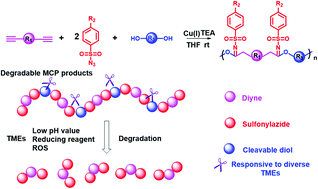Multicomponent polymerization toward biodegradable polymers with diverse responsiveness in tumor microenvironments†
Abstract
Multicomponent polymerization (MCP), as a powerful synthetic tool, has been widely utilized to prepare diverse functional polymers for optical, electronic, and biomedical applications. Here, a Cu(I)-catalyzed MCP toward biodegradable polymers with diverse responsiveness in tumor microenvironments (TMEs) is developed using diynes, sulfonyl azides and a series of TME-responsive, cleavable diols. The resulting polymers showed high molecular weights (up to 12000 g mol−1) and high yields (up to 96%). The biodegradable polymers displayed excellent degradation performance in various simulated TMEs (reactive oxygen species, high reducing reagent, and low pH). One typical photosensitizer, tetraphenyl porphyrin (TPP), was conjugated to the side chains of the polymers for potential application in photodynamic therapy (PDT). The TPP-polymer conjugates displayed enhanced fluorescence intensity and higher singlet oxygen quantum yield than the TPP monomer due to the controlled conjugation efficiency and the unique MCP structure, which provided a complementary strategy to limit the undesired aggregation-caused-quenching (ACQ) effect of PDT.



 Please wait while we load your content...
Please wait while we load your content...